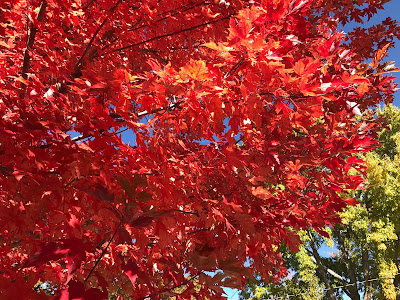 |
| Maple Tree in my neighborhood, Fall 2017 - not this great color this year! |
The high country
foliage color show is mostly over—not along the Front Range, albeit not as good as most years. There are a few maples, hawthorns and other trees around town that are putting on a colorful show.
Trees
Trees
- Recalling from grade school days the science behind leaves changing color each fall—shorter days with less sunlight means a winter break from photosynthesis (you know, when plants make their own food with help from sunlight, water and carbon dioxide).
- The natural substances that make up leaf cells (pigments) become more noticeable each fall as chlorophyll production wanes. Environmental and plant genetic factors affect the pigments in leaves which play an important role in fall leaf color intensity and duration.
- Many warm, sunny days and cool (not freezing nights) allow the anthocyanins pigments to shine through with all those brilliant shades of crimson, purple and red.
- Yellow, gold and orange leaves are fairly consistent from year to year due to carotenoid pigments that remain present in leaves despite the weather.
- Fall moisture helps leaves stay colorful for a longer period of time. Drought conditions while leaves are losing chlorophyll pigments lead to brown leaves and early drop.
- Rake leaves from the lawn as soon as the trees are bare. Leaves that remain during the winter can smother the lawn.
- Dry leaves can be mowed into the lawn, adding back valuable organic matter to the soil. Set the mower height high and make several passes over the leaves.
- Avoid blowing leaves into the street or tossing them in the garbage—many municipalities have collection or drop off sites through early December. Denver leaf drop and post Halloween pumpkin compost information at 3-1-1.
- We’ve only had one or two adequate water producing storms so far this fall along the Front Range. Landscape plant roots need to be moist going into cold weather prior to the ground freezing. Dry plant roots coupled with lack of winter moisture can lead to root and branch death, less foliage, scorched foliage, no foliage or no tree next year.
- Water all plants, trees being the most important. Water well so they enter winter with adequate soil moisture—trees to a depth of twelve inches.
Landscape
- It is a gardener’s choice whether to cut back perennials with dead foliage in the fall or spring. Plants receive additional insulation and protection from our frequent freeze/thaw winter cycles when foliage is left in place. Snow covered foliage can add interest during the winter months.
- Any recent spring or fall planted perennials and shrubs should not be cut back in the fall.
- Birds appreciate seedheads and using the foliage for screening.
- Do not cut back woody plants including butterfly bush, culinary sage, lavender and other late summer or fall blooming plants.
- Established perennials that had disease, harbored insects or may keep the crown too wet through the winter can be cut back in the fall—bee balm, phlox, salvia, Japanese anemone and penstemon to name a few.
- Continue putting in garlic planting stock and spring-flowering bulbs until the ground freezes. To deter critters like squirrels, voles, and mice from bothering newly planted flowering bulbs, sprinkle or roll each bulb in an animal repellent powder during planting. Sprinkle more repellent or hot pepper flakes on top of the soil. Chicken wire can also be placed over the planting hole for additional protection.
 |
| Fall Planted Garlic Cloves |
Vegetables
- Remove spent vegetables and foliage from the vegetable garden, toss if diseased or add to the compost pile.
- Root vegetables that are up and growing (not frozen) including beets, carrots and parsnips and hardy spinach can be thickly mulched (6-8 inches) and harvested through the cold months or until the ground freezes.
Lawn
- Keep watering the lawn each week if the weather is dry. Use hoses and sprinklers if automatic systems are turned off. Water mid-day when temperatures are over 40 degrees. Drain hoses after use.
- Fertilize the lawn while it is green and the ground not frozen. Use one half pound of actual nitrogen per five hundred square feet. Fertilize after aeration.
No comments:
Post a Comment
Note: Only a member of this blog may post a comment.